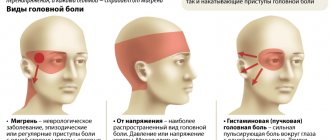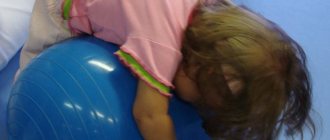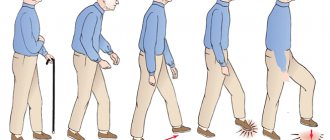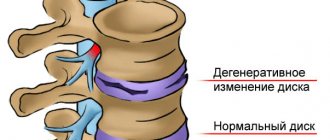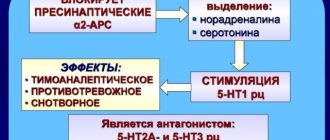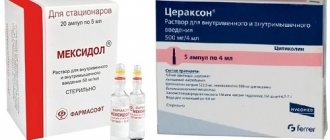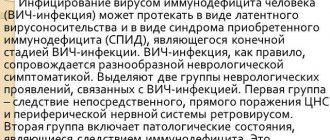Psychoorganic syndrome (PS) is a complex of clinical signs that arise as a result of persistent and irreversible disruption of the structure and functions of the brain, manifested by disorders of memory, emotional sensitivity and intelligence. Organic brain damage is characterized by the presence of pathological changes that can be seen using neuroimaging methods. Any pathological processes are visualized and correlated: tumors, abscesses, benign cysts, hemorrhages, atherosclerosis, amyloid accumulation.
This polyetiological disease clinically manifests itself in old and senile age, which is associated with atrophic processes in the brain tissue and a decrease in the adaptive abilities of the elderly organism to environmental conditions. Sometimes the syndrome develops in young children who have suffered severe infectious diseases or birth injuries. The disease is steadily progressing. Its course periodically stabilizes, the severity of clinical symptoms decreases, and then rapidly increases.
At the first stage of the pathology, patients experience weakness, asthenia, exhaustion of the whole body, instability of behavior, absent-mindedness, clumsiness, and inattention. Then memory gradually deteriorates, intelligence decreases, emotional lability arises, self-criticism decreases, volitional qualities are weakened, and speech becomes unintelligible. These characteristic signs of pathology may be supplemented by others, depending on the area of brain damage. The general psychophysical helplessness of patients is due to a sharp decrease in thought processes, intelligence, ability to work, as well as a violation of the emotional-volitional sphere. Organic disorders can be local or diffuse. In the first case, one type of activity is impaired in patients - memory or intelligence, and in the second - general cerebral symptoms appear.
Neurologists and psychiatrists, as well as doctors of related specialties, are involved in the diagnosis and treatment of pathology. Based on complaints, medical history, clinical signs and the results of additional studies, doctors make a diagnosis. Treatment of PS is symptomatic, pathogenetic, etiotropic. Timely diagnosis and treatment of the syndrome restores lost functions as much as possible and normalizes the state of the nervous system. If the disease is not treated, patients may develop dementia.
PS was discovered by Dr. Eric Beiler at the beginning of the last century. It has an ICD-10 code F00-F09 and the name “Organic, including symptomatic mental disorders.”
Etiology
Psychoorganic syndrome is a polyetiological illness that is a manifestation of somatic and mental diseases that differ in pathogenetic mechanisms and clinical signs. What they have in common is a change in brain structure that often develops without treatment.
- Partial or complete atrophy of brain tissue - Alzheimer's disease, Parkinson's disease, Huntington's chorea.
- Vascular lesions of the central nervous system - atherosclerosis, hypertension, strokes, subarachnoid and subdural hematomas.
- TBI.
An example of organic brain damage is foci of white matter damage.
Nonspecific infectious diseases of the brain are encephalitis, meningoencephalitis, arachnoiditis, brain abscess.- Specific bacterial infections - neurosyphilis, tuberculosis, leptospirosis, brucellosis.
- Viral infections - influenza, chicken pox, measles, mumps, HIV, polio, herpetic lesions of the nervous system.
- Parasitic infestations.
- Neoplasms in the brain.
- Endocrine diseases - diabetes mellitus, Itsenko-Cushing's disease, hypothyroidism, Addison's disease.
- Somatic pathologies - diseases of the heart, kidneys, liver and other internal organs.
- Exogenous intoxication with narcotic and toxic substances, drugs, chemicals, gases.
- Secondary brain damage in systemic collagenoses - rheumatism, vasculitis.
The following factors can provoke the development of the syndrome:
- alcohol abuse,
- deficiency of B vitamins,
- low oxygen content in the blood - hypoxemia,
- metabolic disorder in nervous tissue,
- age characteristics.
Inhibition or complete cessation of the functioning of certain neurons in the cerebral cortex underlies PS. Under the influence of an etiological factor, the functioning of the Krebs cycle malfunctions, glucose absorption deteriorates, glutamate accumulates in neurons, the outflow of cerebrospinal fluid and the blood supply to certain parts of the brain are disrupted. Such metabolic changes are manifested by sleep disturbances, seizures, and psychotic disorders.
Gradually, neurotransmitter mechanisms are depleted, and persistent cognitive dysfunctions arise—decreased memory and intelligence.
Classification of the disease
There are acute, recurrent and chronic psychoorganic syndrome.
Acute form. Characterized by a sudden and sharp onset after a traumatic brain injury, stroke or severe intoxication with toxic substances. It usually lasts several days, in rare cases - weeks. A single episode is possible, but sometimes it can become chronic.
Recurrent form. The state of relative health is replaced by a period of exacerbation of the disease. Characterized by a wavy flow. Relapse may occur due to lack of treatment or its ineffectiveness.
Chronic option. At the beginning, the disease occurs almost unnoticed by others. The development of symptoms depends on age. Often this form takes on a recurrent syndrome in the absence of proper treatment.
All types of psychoorganic syndrome have a progressive course, which leads to irreversible negative changes in the patient’s personality. This condition requires referral to specialists to prescribe optimal therapy.
Symptoms
Clinical manifestations of PS are caused by general asthenia of the body, mnestic disorders, impaired intelligence and emotional background.
- Asthenic signs of pathology - weakness, lethargy, emotional lability, excessive irritability, weather dependence, lack of concentration, decreased performance. Patients are concerned about frequent attacks of headache, dizziness, and thirst. They do not tolerate changes in atmospheric pressure, heat, stuffiness and complain of decreased appetite and sleep disturbances, as well as vegetative symptoms. In mild cases, asthenic signs are the only clinical manifestations. PS can be asymptomatic. In severe cases, clouding of consciousness, memory impairment and a decrease in intelligence, reaching the level of dementia, are added.
- Mnestic disorders are manifested by poor memorization of new data. Patients cannot retain them in their memory and recall already learned facts. In PS, the stages of memorization, retention and reproduction are affected. Dysmnesia, amnesia and confabulation are signs of PS. Disproportional damage to various aspects of memory gradually turns into a complete loss of individual events and is combined with false and fictitious memories. Often patients cannot correctly answer the question: what day, month and year is it today, as well as give the name and patronymic of the attending physician.
- Intellectual impairments are gradually coming to the fore. They consist of a lack of self-criticism, inappropriate behavior, and an inability to abstract from a specific situation. Patients become callous, tactless, dishonest and selfish. They think one-sidedly. As the syndrome progresses, the range of interests narrows. Patients commit wrong actions towards family and friends, and speak tactlessly about them. They perceive the surrounding situation inadequately, cannot grasp the entire situation, and only capture a certain part of what is happening. Sick children “stop” learning and cannot remember and reproduce information according to age standards. In severe cases, they develop dementia.
- In patients, speech function is impaired , vocabulary decreases, and stereotyped phrases often appear. They cannot highlight the main thing in a conversation and are often distracted by minor details. Torpidity of thinking is manifested by difficulty and slow expression of one’s thoughts. Patients repeat the same words several times.
- Emotional lability increases : patients react violently to current events, explosive emotions suddenly arise and disappear just as quickly. They do not tolerate emotional stress well and are unable to restrain their impulses, be it joy or anger. Patients often develop depressive states, hallucinosis, delusions, seizures, twilight disorders, and psychoses. Affective disorders are manifested by attacks of anger, melancholy and angry mood, an explosion of emotions, and mood swings. Patients do not tolerate any irritants well and cannot control their behavior and emotions. They are characterized by pettiness and self-centeredness, characterized by constant hysterics, tearfulness, touchiness, aggressiveness or irritability.
Clinical signs of the syndrome depend on the location of the lesion. When the brain stem is damaged, indifference, lethargy, passivity, and sometimes rudeness and euphoria predominate. Tumors and injuries of the frontal lobes are manifested by sloppiness, foolish behavior, and a tendency to flat humor. When the lesion is located in the occipital or parietal region, patients are bothered by persistent headaches and blurred vision.
Psychoorganic syndrome in children
PS is rare in children. The causes of the disease in the perinatal period are: chromosomal diseases, fetal hypoxia, radiation, ecology, alcoholism or drug addiction of a pregnant woman, poor nutrition, acute or chronic diseases of the mother, pathology of pregnancy.
Clinical signs of the syndrome in children:
- hyperexcitability of the nervous system,
- frequent regurgitation and vomiting,
- stool disorders,
- allergic reactions,
- sleep and appetite disorders,
- hypersensitivity to sounds and light,
- anxiety,
- frequent moodiness and unstable moods,
- delayed speech development.
Gradually, psychoemotional and motor disorders begin to predominate in patients. At the same time, asthenic and vegetative signs fade into the background. Children become annoying and impulsive, irritable, and emotionally unbalanced. Excessive physical activity is accompanied by many unnecessary movements. They perceive and assimilate new information poorly due to impaired concentration. Gradually, cognitive functions deteriorate, self-criticism disappears. Children lose self-control, become angry and aggressive. In their close circle, they see only “enemies” who do not understand them at all.
Main symptoms of the disease
Memory impairment. There is a significant decrease in the fixation type of memory. A person begins to have difficulty assimilating new information. Often forgets what he did a few minutes ago or cannot retell what he is doing at the current time. It is difficult for a person suffering from this syndrome to maintain the correct chronology of recent events. Other types of memory may also suffer.
Intellectual impairment. With such disorders, a person’s cognitive activity decreases and his range of interests narrows. He begins to operate with simpler judgments, cannot perceive the situation as a whole, logic and the separation of the particular from the general suffer. Lengthy discussions emerge. Thinking becomes rigid, that is, it is difficult for a person to change the plan of activity or switch to something new.
Changes also affect personality. A person becomes more rude, egocentrism increases, and people around him cause negativity and dissatisfaction. Often the patient does not have a critical attitude towards his condition.
Emotional disorders. Psychoorganic syndrome is characterized by neurosis-like disorders:
- various fears (phobias, nightmares);
- increased anxiety;
- excessive activity or lethargy;
- obsessing over one’s health and looking for serious illnesses;
- depression;
- bouts of aggressiveness.
A person's emotions become poorer. Indifference appears, which is sometimes interrupted by a violent emotional reaction. Sudden mood changes are possible.
Variants of psychoorganic syndrome
The following flow options are distinguished:
- The asthenic variant is physical weakness, exhaustion of the nervous system, decreased performance, pronounced changes in intelligence and memory, emotional incontinence, disorientation in situations, constant excitement and anxiety. Fluctuations and flickering of visual images, bright light and loud sound, closed space cause nausea, headache, and moral discomfort in patients. Such patients avoid people and often withdraw into seclusion. They carry out everyday activities quite calmly, but do not show interest in new events.
- Explosive option - a clear decrease in intelligence, difficulties in performing basic tasks, anger, irritability, isolation, attacks of unjustified aggression. Patients are often nervous, constantly sorting things out, making scandals, quarreling, and losing control of themselves. Aggression gives way to hysterics and loud crying.
- Moderate or euphoric version - impaired mental activity, decreased performance, causeless mood swings. Aggression and anger, hypersensitivity and tearfulness are replaced by attacks of high mood. Patients are often agitated, laugh loudly and a lot, gesticulate and attract everyone's attention.
- The apathetic option is a sharp narrowing of the range of interests, indifference to everything, decreased memory, lack of spontaneous actions, weak thinking, slowness. Severe PS is characterized by complete apathy of patients and a gradual decrease in mental abilities. They avoid communication, have difficulty maintaining conversations, and cannot switch from one topic to another.
According to the current, acute and chronic PS are distinguished. The cause of the acute form is a sudden and sharp effect on the brain of etiological factors - infectious agents, traumatic injury, intoxication. Signs of pathology disappear after the identified causes are eliminated. Chronic syndrome is a manifestation of long-term vascular and somatic diseases, alcohol abuse. Chronic PS requires treatment, since the regenerative and adaptive abilities of the nervous system gradually decrease.
Options
Occasionally, rudimentary signs of delirium, as well as twilight disorder of consciousness, occur at night. In some cases, depressive states, epileptiform seizures with signs of derealization, hallucinations, delusional syndromes, and periodic psychoses (depersonalization) are noted. There are cases when the symptoms of psychoorganic syndrome stabilize and become reversed. Often, under the influence of physical, external psychotraumatic influences, this syndrome acquires progressive development, and also acquires degrees of organic dementia, namely dementia.
Psychoorganic syndrome and its variants: apathetic, explosive, asthenic, euphoric.
The asthenic variant is marked by disorders in the form of physical and mental exhaustion, which causes manifestations of irritability, hyperesthesia, weakness, and affective lability. With this option, the disorder of intellectual functions is expressed insignificantly, and mild dysmnestic disorders rarely appear. The depth of the asthenic variant is assessed by Pirogov's symptoms.
The explosive variant includes a combination of affective excitability, aggressiveness, irritability, explosiveness, with weakened obvious dysmnestic changes and decreased adaptation. The explosive variant is characterized by a tendency towards paranoid, overvalued formations, which leads to a weakening of volitional inhibitions, increased desire, and loss of self-control. Patients are often prone to alcoholism. Initially, alcohol is used to improve mood, relieve irritation and excitability, but frequent use worsens the general condition and also increases the manifestation of signs of organic failure, which leads to a forced increase in the alcohol dose. Next, many patients begin to experience hangover symptoms.
The explosive option also includes the formation of super-valuable formations, as well as querulant tendencies. There are various hysterical reactions characteristic only of patients in this group, which indicates severe signs of the manifestations of the disease.
The euphoric variant is marked by an increase in mood, accompanied by a shade of complacency and euphoria, confusion, increased drives, dysmnestic disorder, as well as a sharp increase in criticism towards oneself. Some patients are explosive, expressing anger and aggression, which are replaced by helplessness, incontinence of affect, and tearfulness. Patients with the disease experience decreased performance. Symptoms of forced laughter, as well as forced crying, are a manifestation of particular severity.
The apathetic variant is marked by apathy, indifference to the environment, a narrowing of the range of interests, as well as dysmnestic disorders. The apathetic variant attracts attention with symptoms of epileptic disease and schizophrenia.
Acute and chronic variants of psychoorganic syndrome are noted.
The acute version begins suddenly and often follows an exogenous type of reaction. Its duration ranges from several days to weeks. The acute variant can be a single episode or recur and become chronic.
The chronic variant is hardly noticeable and has a different course with diseases such as Huntington's chorea, Alzheimer's disease, Pick's disease, and senile dementia. There is a reverse development of symptoms up to certain limits.
Complications
In the absence of timely and correct treatment of PS, severe complications develop:
- disturbance of consciousness,
- depression,
- rave,
- hallucinosis,
- seizures,
- derealization and depersonalization,
- dementia.
Stabilization of PS or its reverse development are favorable outcomes of the pathology. Under the influence of negative psychotraumatic factors, the syndrome develops progressively and reaches organic dementia. Patients lose contact with society, lose self-care skills, and become completely disabled.
Diagnostic procedures
Diagnosis of PS is based on anamnestic data, results of examination of the patient and characteristic clinical manifestations. Patients with signs of pathology require consultation with a specialist in the field of neurology, vascular surgery, venereology, endocrinology, cardiology, and gastroenterology. Additional research methods that allow a final diagnosis to be made are blood and urine tests, CT and MRI of the brain, X-ray of the skull, angiography with contrast, myelography, Dopplerography, EEG.
Therapeutic measures
Treatment of PS is etiotropic, aimed at eliminating the disease that has become the root cause of the disease, as well as symptomatic, eliminating the main clinical signs and improving the general condition of patients.
Drug therapy:
- nootropic drugs - Piracetam, Phenotropil, Semax, Cerebrolysin;
- neurotrophics – “Xanthinol”, “Vinpocetine”;
- cerebroprotectors and neuroprotectors – “Cortexin”, “Glycine”, “Gliatilin”;
- vitamins B, C, E, nicotinic acid;
- antioxidants – “Mexidol”, “Emoxipin”;
- antipsychotics – “Aminazine”, “Sonapax”, “Tizercin”;
- broad-spectrum antibiotics - Amoxiclav, Clarithromycin, Cefazolin;
- glucocorticosteroids - “Prednisolone”, “Diprospan”, “Betamethasone”;
- antiviral drugs - Valtrex, Acyclovir, Ingavirin;
- anticonvulsants – “Carbamazepine”, “Finlepsin”.
Physiotherapeutic procedures improve the functions of the central nervous system, strengthen the immune system and activate the body's defenses, increase the ability to adapt to changing environmental conditions. Patients are prescribed salt or pine baths, electrophoresis, magnetic therapy, paraffin therapy, reflexology, massage and manual therapy, ultrasound, thermal stimulation, and current pulses. All physiotherapeutic procedures are carried out after the acute symptoms of the disease have subsided and in the absence of contraindications.
Traditional medicine used to treat PS together with traditional drugs:
- Take fresh carrot juice daily.
- Infusion of peppermint with chamomile and valerian.
- Infusion of hawthorn fruits.
- Tea made from viburnum berries and sea buckthorn.
- A decoction of thyme, mint and motherwort.
- Tea made from dry birch leaves.
- A collection of lemon balm, oregano, wild carrots, lily of the valley, hawthorn.
PS has an undulating course with periods of exacerbations and remissions. It is impossible to completely get rid of the pathology: organic brain damage is a lifelong process.
Treatment
The drug is contraindicated in cases of severe impairment of liver and kidney function.
Patients with psychoorganic syndrome require adequate therapy. Without it, their chances of feeling better are zero. Patients are offered etiotropic treatment. Its action is aimed at eliminating the root cause of the disorder, as well as suppressing progressive symptoms.
Medications help patients cope with the painful condition:
- Nootropic drugs (“Semax”, “Piracetam”);
- Antioxidants (“Emoxipin”, “Mexidol”);
- Vitamins B, C and E, as well as preparations with nicotinic acid;
- Neurotrophics (“Vinpocetine”, “Xanthinol”);
- Neuroprotectors (“Glycine”, “Cortexin”);
- Antibiotics (“Cefazolin”, “Amoxiclav”);
- Antiviral medications (Acyclovir, Valtrex);
- Anticonvulsants (Finlepsin, Carbamazepine).
The course of drug treatment should be selected for the patient individually, depending on the problems that are troubling him and the individual characteristics of the body.
In addition to the medication course, patients are offered physiotherapeutic procedures. Their main task is aimed at strengthening the body’s defenses and increasing a person’s ability to adapt to the environment. Patients are prescribed the following procedures:
- Electrophoresis;
- Magnetic therapy;
- Coniferous and salt baths;
- Paraffin therapy;
- Reflexology;
- Massage;
- Thermal and ultrasound stimulation.
Physiotherapeutic treatment can be started only after the severity of painful symptoms has been suppressed. It is also important to check the patient for contraindications to certain procedures before starting the course.
Forecast
The prognosis of PS depends on the etiopathogenetic factors that caused it. As the pathology progresses, patients drop out of society, stop caring for themselves, and become completely dependent on the people around them. Persistent disability is caused by physical and intellectual disorders. Currently, there is no data on the cure of patients with PS. Modern medicine and the pharmaceutical industry are constantly looking for new ways to combat the disease. It is possible that a specific treatment for the syndrome will soon be available.
© sindrom.info
